The BeamPro management application is for managing Beam users and devices within your company or organization. To manage Beam+™ devices, please consult the Beam+ Quick-Start Guide. To manage users and devices in your organization you must be a Beam administrator for your organization.
Logging In
-
Browse to suitabletech.com and click “Login” in the top right corner.

-
Enter your Beam ID and password or select the “Sign in with Google” button if you’d like to authenticate with your Google account.
-
Once logged in, click the button with your name in the top right corner to open the user menu.
-
Select “Manage My Beams”.
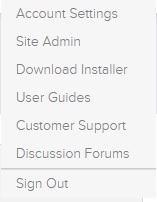
Note: If you are an administrator for multiple organizations, you can choose the organization for which you want to make changes from a drop-down list in the upper-right corner of the aplication.
-
On the management page, you will see the following options at the top of the page:

- Dashboard - Buttons for common activities as well as a list of recent Beam activity within the organization.
- Beams - Manage and configure Beams, Device Groups and set access and access times for these groups.
- Users - Manage and configure Users and User Groups.
- Activity - Monitor activity and run activity reports for Beam usage within an organization.
Onboarding a New User
Listed below are the steps to add a new Beam user to your organization.
From your organization’s dashboard…
-
Click “Invite a New User”
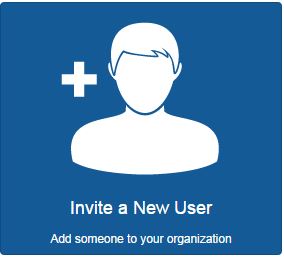
-
Complete the “Invite a New User” form:
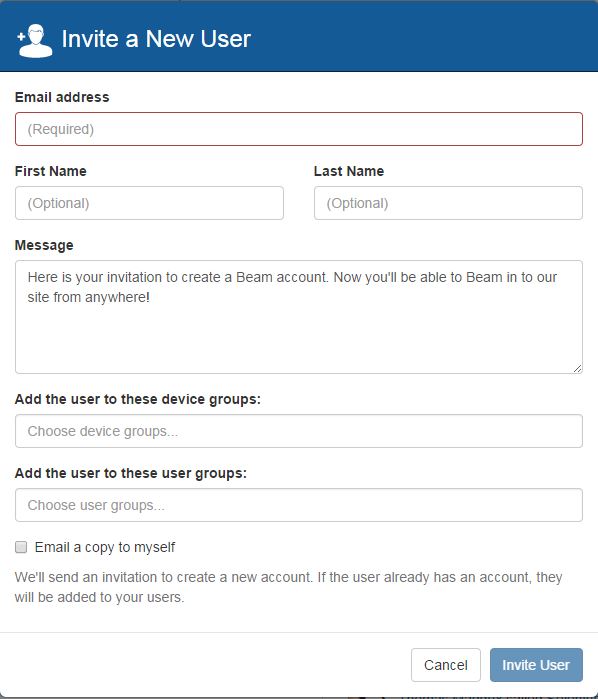
- Input the user’s email address (required, must be a valid email address).
- Enter first name (optional).
- Enter last name (optional)
- Select any user groups to which you’d like to add the user. (Optional, multiple selections allowed).
- Select any device groups to which you’d like to add the user. (Optional, multiple selections allowed).
- Select the “Email a copy to myself” option if you would like a copy of the invite email for your records. Note: The password link in the copy of this message will be removed for security purposes.
- Click “Invite User” button.
-
Invited users will be notified via email with the following information:
- Who invited them (Your organization and your name)
- Which device groups they can access
- Their user name
- A link to create a password and get the Beam application
-
After sending the invitation, the user will be added to your organization.
Granting Temporary Access
Listed below are the steps to give a user access to a Beam or group of Beams for a specified period of time.
From your organization’s dashboard…
-
Click “Invite Temporary User”
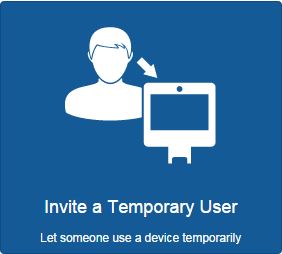
-
Complete the “Invite a Temporary User” form

- Enter an email address (required, must be a valid email address)
- Enter first name (optional)
- Enter last name (optional)
- Choose a device group that the user will have access to (required)
- Enter a Starting Date (required)
- Input an Ending Date (required)
- Enter a Start Time (required)
- Enter an End Time (required)
- Choose whether the temporary user will “Require Session Answer”. Note: This option requires someone local to the Beam to acknowledge the session request before initiating the session, helping to avoid accidental eavesdropping.
-
Click the “Invite” button.
-
Invited users will be notified via email of the following:
- Who invited them (Your organization and your name)
- Which device group(s) they can access
- Access Times to each assigned device group
- Their user name
- A link to create a password and get the Beam application
-
After sending the invitation, the system will create a temporary access time during which the user can call Beams in the specified device group.
Importing New Users From a CSV File
Listed below are the steps to import multiple new Beam users into an organization.
-
Create a CSV file with one user per line in the following format:
email_address,first_name,last_name -
Click “Import Users”
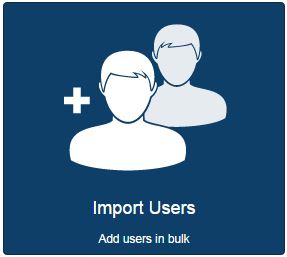
-
Click the “Choose File” button and browse to your CSV user file. Note: You will have a chance to confirm the list of users and customize the invitation email in the next step.

-
Complete the “Import Users” form.
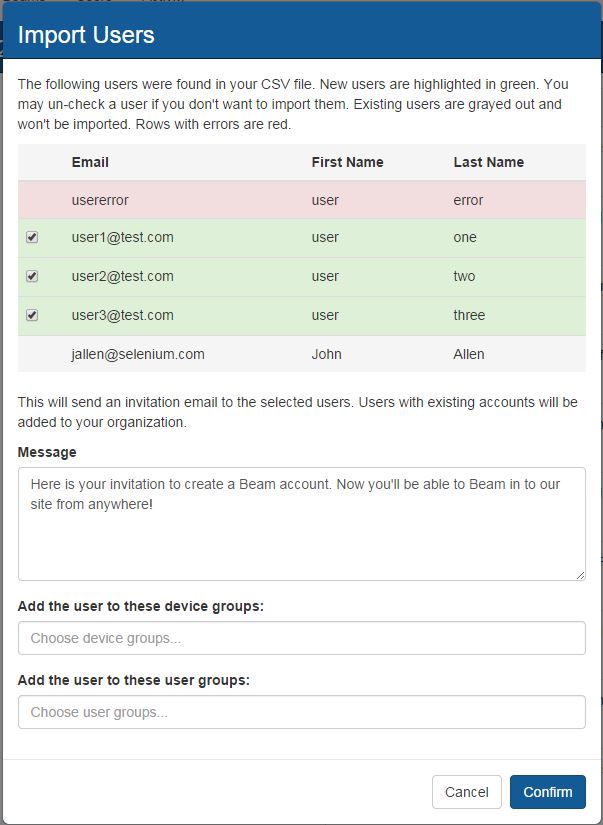
- New users are highlighted in green.
- You may uncheck a user if you do not want to import them.
- Existing users are highlighted in grey and will not be imported.
- Users with errors are highlighted in red.
- Select any user groups to which you’d like to add the users (optional, multiple selections allowed)
- Select any device groups to which you’d like to add the users (optional, multiple selections allowed)
-
Click the “Confirm” button.
-
Target Users will be notified via email of the following:
- Who invited them (Your name and your organization)
- Which device groups they can access
- Their user name
- A link to create a password and get the Beam application.
-
After sending the invitations, each new user will be added to your organization.
Creating a User Group
Listed below are the steps to create and add users to a new User Group. Placing users in different groups allows the administrator to regulate access to a Beam or groups of Beams.
From your organization’s dashboard…
-
Click on the “Users” tab.
-
Click on the “Create New User Group” button at the upper right.

-
Enter the user group’s name and select “Create User Group”.
-
Click the “Add Users” button in the upper left area, below the user group’s name.
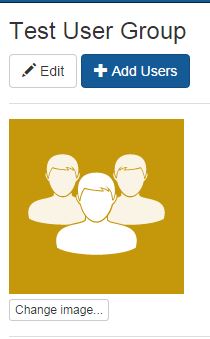
-
Complete the “Choose Users” form.
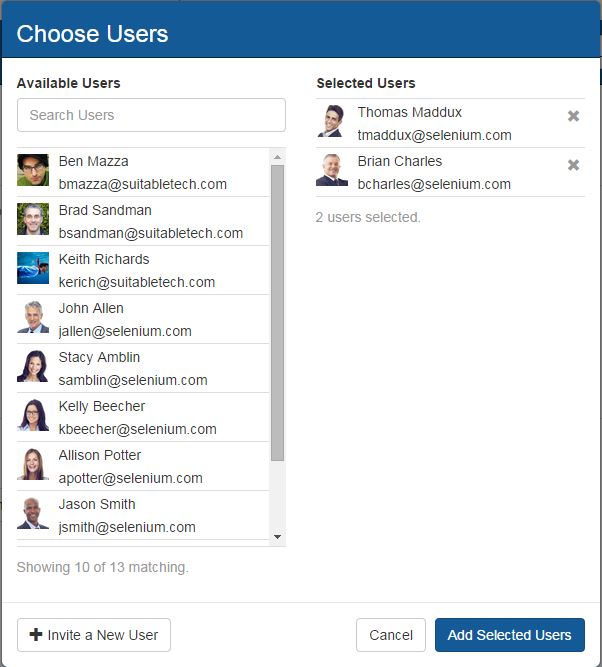
-
Select users to add (required)
-
Click the “Add Selected users” button when all users have been selected.
-
The new group will appear with other user groups at the top of the users page.
Changing a User Group’s Icon
Listed below are the steps to change the icon displayed for a user group when browsing in the “Users” tab.
From your organization’s dashboard…
-
Click the “Users” tab.
-
Click on the user group you’d like to edit.
-
Click the “Change Image…” button.

-
Click “Choose file…” and find the image you’d like to use.
-
Click “Open”.
-
Crop the image, then click “Save”.
Adding Users to an Existing User Group
Listed below are the steps to add users to an existing user group. Placing users in different groups allows the administrator to regulate access to Beams
From your organization’s dashboard…
-
Click the “Users” tab.
-
Click the user group you’d like to edit.
-
Click the “Add Users” button in the upper left area, below the user group’s name.

-
Complete the “Choose Users” form.

-
Select users to add (required)
-
Click “Add Selected Users”
Creating a New Device Group
Listed below are the steps to create and add Beams to a new device group. Placing Beams in different groups allows the administrator to regulate access to a Beam or groups of Beams in different departments or locations.
From your organization’s dashboard…
-
Click the “Beams” tab.
-
Click the “Create Device Group” button

-
Complete the “Create Device Group” form.
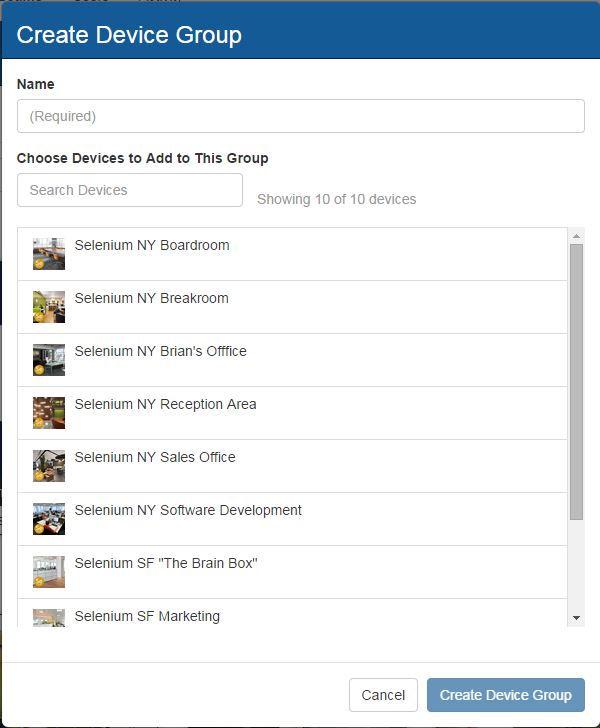
- Choose a name for the new device group (required)
- Select Beams to add to new device group. (optional) Note: If a Beam already belongs to another Device Group, it will be removed from its old group.
-
Click the “Create Device Group” button.
Setting Up Newly Acquired or Newly Paired Beams
Listed below are the steps to configure a newly acquired Beam.
From your organization’s dashboard…
-
Click the “Beams” tab.
-
Find the Beam you’d like to change and click on it.
-
Click the “Edit” button.
-
Complete the “Edit Device” form.

- Choose a name for the Beam. (required)
- Set the location of the Beam. (optional)
- List any labels for the Beam, i.e. “3rd Floor Conference Room” or “For Jim to Use”.
- Select the Time Zone where the Beam is located (required).
- Select the desired device group of the Beam (required).
-
Click the “Save Changes” button.
Changing a Beam’s Profile Image
Listed below are the steps to change the image/icon displayed for a Beam when browsing in the “Beams” tab.
From your organization’s dashboard…
-
Click the “Beams” tab.
-
Find the Beam you’d like to edit and click on it.
-
Click “Change Image” button below the current image.

-
Click “Choose file…” and find the image you’d like to use (.jpg, .gif or.png format).
-
Click “Open”.
-
Crop image to your liking, then click “Save”.
Managing a Device Group
Every one of your Beams lives in a device group. Device groups let you choose access times, manage permissions, and apply settings to one or more Beams at a time.
To allow users to access Beams in a device group, you must add them to the group. You can add users individually or you can add entire user groups.
Adding Individual Members to a Device Group
To add individual users to a device group:
-
Click on the “Beams” tab.
-
Select the device group you want to add users to.

-
Select the “Members” tab.

-
Click on the “Add Users” button located in the top right hand corner of the screen.

-
Choose the users you would like to add and click the “Add selected users” button.
Adding User Groups to a Device Group
To add user groups to a device group, follow the instructions above for adding individual members, but select one or more user groups in the “Choose Users” dialog. You can add both individual users and user groups at the same time.
Setting Access Times for a Device Group
By default, device group members will have access to the Beams in the group around the clock, 24 hours a day, seven days a week. If you’d like to change this, you can create more granular access times that restrict access during certain hours of the day.
For each access time, the Session Answer feature can be turned on or off. When Session Answer is enabled, someone local to the Beam or an administrator must accept the session request before the session is initiated. This feature is to avoid accidental eavesdropping.
Viewing Access Times for a Device Group
From your organization’s dashboard…
-
Click the “Beams” tab, then select a device group in the dropdown menu.
-
Click “Access Times” tab.

Creating an Access Time for All Members
You can create access times that will be shared by all members in the group (unless you specifically disable this behavior for specific members). By default, there is already a single access time for all members: All day, every day. You can remove this access time and create more restrictive access times.
-
Click “Add Access Time” button below “Access Times for All Members”

- Select each day that group members have access to this device group.
- Select time of day when all group members have access. You can pick either “All day” or a specific time range.
- If you’d like to require users’ sessions to be answered by a local or an administrator during this time, select “Require Session Answer”.
-
You can add as many access times for all members as you like.
Editing Access Times for All members
-
Click on the the access time description you wish to edit under “Access Times for All Members”.
-
Select each day that group members have access to this device group.
-
Select time of day all group members have access: Either “All day” or choose a time range.
-
If you’d like to require users’ sessions to be answered by a local or an administrator during this time, select “Require Session Answer”.

Setting Access Times for Users or User Groups
Set access times by clicking on “Add Access Time” under the “Members” heading or by clicking on a member. You can edit or delete a member’s access time by choosing it below their name in the menu. You can also click and drag on the calendar to create new access times, or click on access times in the calendar to edit them.

- Select the user or user group to which you’d like to apply this access time.
- Select each day that the member should have access.
- Select the time of day when the member should have access: Either “All day” or choose a time range
- If you’d like to require users’ sessions to be answered by a local or an administrator during this time, select “Require Session Answer”.
You can add as many access times for members as you like.
Adding or Editing Temporary Access Times
You can grant temporary access to users by clicking and dragging on the calendar and choosing “Invite a Temporary User”:

You can also invite temporary users by clicking on “Invite Temporary User Button” from the left column:

You can edit existing temporary access times by clicking on them in the calendar or in the menu in the left column.
- Select the user to which you’d like to apply this temporary access time.
- Select the date and time when access should begin.
- Select the date and time when access should end.
- If you’d like to require the temporary user’s session to be answered by a local or an administrator during this time, select “Require Session Answer”.
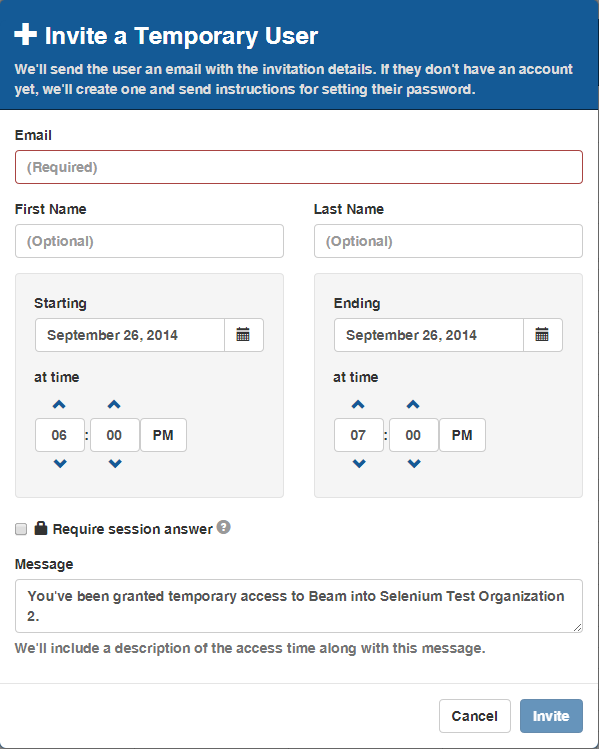
You can create more multiple temporary access times for a user.
Changing Device Group Settings
Listed below are the steps to change the settings for a device group.
From your organization’s dashboard…
- Click the “Beams” tab
- Find the device group you’d like to edit and click on it.
-
Click the “Settings” tab

Adding Device Group Administrators
You can choose users to administer this device group. They won’t be able to change your organization’s settings or the settings of other device groups, but they will be able to invite and accept new users, change device group settings, and change settings for devices within this device group.
Setting Device Group Notifications
- Under “Notifications”, click the “Add User” button to choose which users will be notified if a Beam is left off the charger (optional)
- Select “Also notify last pilot if a Beam is left off charger” if you’d like the last pilot to be notified as well (optional)
Setting Who Can Answer Incoming Sessions
Under “Session Answer”, click the “Add Users” button to choose which users can accept sessions requests for Beams in this group. Note: Users with Session Answer privileges must be logged into the Beam client to answer Beam sessions. Locals can always answer incoming sessions by tapping on the Beam when it is ringing.
Setting Device Group Authentication
Choose which authentication methods are required for accessing this device group.
- All authentication methods - Allows for Suitable Technologies (username and password), Google authentication, or any future authentication methods that are added.
- Suitable Technologies - Allows only Suitable Technologies authentication (username and password) for this device group.
- Google - Allows only “Sign in with Google” authentication for this device group.
Monitoring Beam Activity
Listed below are the steps to monitor Beam activity for an organization.
From your organization’s dashboard…
-
Click the “Activity” tab.
-
Specify the date range and state of activity to monitor (In a call, Missed Calls, Offline, Configuring, or Upgrading)

Each device with activity during the specified range will be listed.
-
Click on an event in the timeline to view its details.

-
Left click and drag to navigate along the timeline.
-
Zoom in or out of the timeline using your mouse wheel or by scrolling on your trackpad.
Exporting Activity Events
To do more in depth analysis of Beam usage, you can download a CSV file of the activity by clicking the “Export CSV” button.

Managing API Keys
If you’d like to automate certain aspects of managing Beams in your organization, you can use the Beam Administration API. Documentation for the Beam Administration API is available here:
To access the API, you’ll need to create an API key for your organization.
Creating an API Key
-
Click the “Settings” icon on top right of screen.

-
Under “API Keys,” enter a name for your new key.
-
Click the “Create New API Key” button.
-
Your new API Key entry will be created. Important! Copy the API Key and store it somewhere safe. Once you leave this page, you will no longer have access to the secret portion of the key. We don’t store the secret portion directly.
Deleting an API key
If your API key is compromised, or you’re no longer using it, you can delete the key. Simply select the “delete” option to the right of the key’s name.